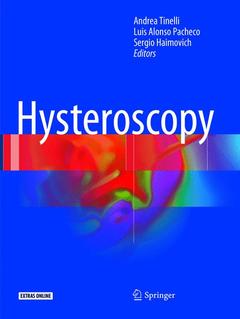Description
Hysteroscopy, 1st ed. 2018
Language: English
Subjects for Hysteroscopy:
Publication date: 06-2019
756 p. · 21x27.9 cm · Paperback
Publication date: 02-2018
Support: Print on demand
Description
/li>Contents
/li>Biography
/li>Comment
/li>
This book offers a cutting-edge guide to hysteroscopy and provides readers with the latest and most essential information on procedure techniques, clinical advances and international developments in practice and treatment of endometrial pathology. Providing comprehensive coverage, it explains in detail every aspect of hysteroscopy, from diagnostics to hysteroscopic surgery. As such, it addresses the bases of hysteroscopy; pre-, intra- and post-hysteroscopy medications; intracavitary pathologies; fertility issues; and surgical implications and complications. At the same time, it also explores challenging and controversial topics, such as hysteroscopy and ART, submucous myomas, and uterine malformations.
All topics are discussed by prominent experts in the field, and clearly organized and illustrated to help readers gain the most from each chapter. Accordingly, the book offers a valuable resource for all gynecologists working at hysteroscopy units, reproductive units, gynecological and oncological units, as well as a quick reference guide for all other physicians interested in the topic.
Part I Office Hysteroscopy: Vaginoscopic approach.- How to set up a hysteroscopic unit.- The use of anesthesia in hysteroscopy.- “In office” hysteroscopy.- Part II Uterine malformations: What's new about the classification of uterine malformations?.- Role of the 3D in the evaluation of the uterine anomalies.- Uterine septum.- Unicornuate uterus: is there a place for the hysteroscopic management?.- Part III Hysteroscopy and Menopause: Postmentrual bleeding and hysteroscopy: Overview.- Pain control in hysteroscopy in postmenopausal women.- Polypectomy US Cut-off.- Hysteroscopy or curettage?.- Part IV Improving pregnancy Rates: Hysteroscopic embryo Transfer.- Hysteroscopy in patients with repeated implantation failure.- Outpatient hysteroscopy in Recurrent pregnancy loss.- Dysmorphic uterus and pregnancy outcomes.- Part V Hysteroscopy And Assisted Reproduction Techniques (ART): Hysteroscopy before in-vitro fertilisation (inSIGH).- Hysteroscopy in improving reproductive outcomes of infertile couple.- Uterine Causes of infertility. What's new?.- Refractary Endometrium and Hysteroscopy.- Part VI Hysteroscopy and drugs: Tamoxifen: an update.- How the ulipristal acetat afects the hysteroscopic myomectomy?.- Endometrial presurgical preparation.- Cervical ripening.- Part VII Hysteroscopy and Oncology: Endometrial Hyperplasia.- Hysteroscopy classification for endometrial cancer.- Early stages, Is there a place for hysteroscopic treatment?.- Is there retrograde seeding of malignant cells?.- Part VIII Hysteroscopy in Contraception: Hysteroscopy and contraception: an overview.- Side effects review. Is really there a problem?.- Managing difficult insertion and removal.- Essure and IVF.- Part IX Submucous Myomas and Hysteroscopy: Physiology and Importance of the myoma´s Pseudocapsule.- Hysteroscopy Myomectomy: respecting the pseudocapsule.- Myomectomy in Theater: Alternatives to resectoscopy.- Is the distance betweenmyoma and serosa a limiting factor.- Part X Cesarean scar defect (CSD): Why some women develop CSD?.- Surgical management of cesarean scar defect.- Hysteroscopic treatment of the cesarean-induced isthmocele in restoring fertility.- Pregnancy over cesarean scar defect.- Part XI Adenomyosis: Adenomyosis: overview.- Hysteroscopic patterns of the adenomyosis.- Treatment of the adenomyosis in IVF.- Cystic adenomyosis.- Part XII Endometrial ablation: System and method for endometrial ablation.- Predictors of endometrial ablation failure.- Complications at endometrial resections.- Is there still a place for it in modern practice?.- Part XIII Pregnancy relate: Embryoscopy today.- Performing hysteroscopy during pregnancy.- Cervical ectopic pregnancy.- Retained Products of conception. Hysteroscopic management.- Part XIV Submucous Myomas and Office Hysteroscopy: Myoma´s classification and correlation with surgical outcome.- New devices and techniques: what are the limits?.- Medical preparation/treatment previous to hysteroscopy.- Breaking the limits in office hysteroscopy.- Part XV Formation in Hysteroscopy: How to improve my hysteroscopic skill.- What's the role of the hysterotrainers in the new era.- New virtual-reality training simulator.- The Chinese formation model.- Part XVI Infections / inflamations: Chronic Endometritis.- TBC and Hysteroscopy.- Management of proximal tubal occlusions.- Management of Endometritis before ART.- Part XVII Asherman’s Syndrome: Intrauterine adhesions: Etiopathogenesis.- Adhesions and abortion.- Hysteroscopic treatment of Asherman’s Syndrome.- Prevention of the adhesion reformation alter hysteroscopic surgery.
Andrea Tinelli completed his medical degree magna cum laude at the School of Medicine, University of Naples Federico II in 1996, and completed his specialization in Obstetrics and Gynecology cum laude at the University of Trieste, Italy in 2000. He currently works at the university-affiliated “Vito Fazzi” Hospital in Lecce, Italy, as Chief of the Division of Experimental Research in Endoscopic Surgery, Imaging, Minimally Invasive Technology, and Therapy (ObGyn Department). From January 2014, he has held National Authorization as an Associate Professor in Obstetrics and Gynecology, and he is an Adjunct Professor at the Moscow Institute of Physics and Technology (MIPT), Russia, as a member of the International Translational Medicine & Biomodeling Research Team. Dr. Tinelli is also a permanent Member of the Committee on Experimental Oncological and Pathological Medical Research at the University of Salento, Italy. He is the author or co-author of eight books, more than 360 papers in peer-reviewed medical journals, and 32 textbook chapters. He is an active member of national and international scientific and professional associations and serves as an editorial board member for various scientific journals.
Dr. Tinelli’s clinical specialties include: minimally invasive surgery and gynecological endoscopy, gynecological surgical oncology, molecular biology in gynecology, endometriosis and pelvic floor repair.
Luis Alonso Pacheco is board certified and fellowship trained in the area of hysteroscopy. He received his medical degree from the University of Valladolid and his title of specialist in obstetrics and gynecology from the Universitary Regional Hospital “Carlos Haya” Málaga. After finishing his specialization, he worked in Hospital Materno infantil de Málaga until 2002. Endoscopic surgery consultant of Hospital Xanit Internacional from 2006 until 2009. Professor of the Andalusian Endoscopic School from 2006 to 2009. Currentlyis




